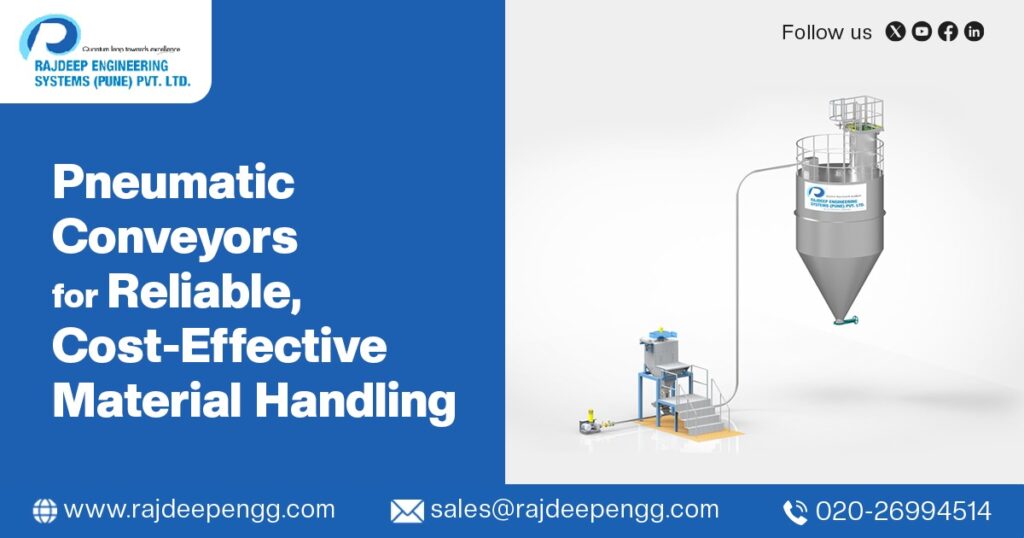The Power of Pneumatic Conveyors
Pneumatic conveying systems are designed to move bulk materials, powders, and particles using airflow or gas under vacuum. They offer a more cost-effective solution compared to traditional mechanical conveying systems and are versatile across various industries. By embracing innovation and leveraging advanced technologies, companies can reduce operational costs, enhance flexibility, and boost productivity and product quality.
How Pneumatic Conveyors Work
Pneumatic conveyors transfer materials efficiently from one location to another using air. They handle dry, free-flowing bulk products effectively, while flexible screw conveyors cater to more challenging materials, including non-free-flowing, moist, and fat-containing substances. Key benefits of pneumatic systems include:
- High-Speed Operation: Pneumatic conveyors move materials quickly, enhancing overall process efficiency.
- Low Maintenance: These systems require minimal upkeep, making them a cost-effective choice.
- Energy Efficiency: Pneumatic conveyors are designed to be energy-efficient, reducing operational costs.
These systems are ideal for conveying materials from trucks, railcars, or silos and can also be equipped to control dust, preventing material from sticking to belts. Pneumatic systems are made up of several complex components, each tailored for specific tasks. A typical pneumatic conveying system is best suited for moving dry, low-density products like sugar, cement powder, sand, and aggregates.
Pneumatic Conveyor Systems Specifications
Pneumatic conveyors use differential air pressure to move materials efficiently. Air flows from high to low pressure, pushing bulk materials from one end of the pipe to the other. There are two main types of pneumatic systems:
- Negative Pressure Systems: Utilise a vacuum to pull materials through the pipeline.
- Positive Pressure Systems: Employ compressors to push materials through the pipeline.
Different materials require different machine designs based on their shape, size, weight, and physical properties. This is achieved by adjusting the pressure, quantity, and velocity of the air stream.
Dilute Phase vs. Dense Phase Conveying Systems
Pneumatic conveying systems are categorised into two main methods: dilute phase and dense phase.
- Dilute Phase Conveying: This method uses low pressure differential and high velocity to transport less dense particles. It is characterised by a low material-to-air ratio and is suitable for moving light materials in smaller quantities.
- Dense Phase Conveying: This method uses high pressure differential and low velocities, creating a high material-to-air ratio. It is ideal for transporting bulk substances efficiently using less air. Dense phase systems can be further categorised into plug type and continuous type. Recent advancements have introduced mechanisms that introduce air at multiple points along the pipeline, enhancing efficiency and reducing power consumption.
Applications in Various Industries
Both dilute and dense phase conveying systems are widely used across industries. They are employed to move construction materials like cement and sand, minerals such as alumina, lime, and gypsum, as well as powders for dust collection systems and raw cement during manufacturing.
Advantages of Pneumatic Conveying
Pneumatic conveyors offer several advantages over mechanical handling systems:
- Flexible Routing: Pipes can be bent and routed in various directions, reducing the need for mechanical devices and lowering initial costs.
- Space Efficiency: Pneumatic systems require less space compared to mechanical conveyor belts.
- Long-Distance Conveyance: These systems can transport materials over long distances cost-effectively.
- Reduced Pollution: Materials are conveyed in closed pipes, minimising pollution and eliminating the need for separate dust collection systems. This is especially beneficial for handling food powders like flour and grains, which remain less contaminated.
Conclusion
Pneumatic conveying systems provide a reliable, cost-effective solution for material handling, offering high-speed operation, low maintenance, and energy efficiency. With their ability to handle a wide range of materials and applications, they are an invaluable asset in modern industrial operations.
For over 25 years, Rajdeep Engineering Pvt. Ltd. has been a leader in providing high-quality material handling system machines, leveraging extensive experience to deliver innovative solutions that enhance operational efficiency and productivity.

